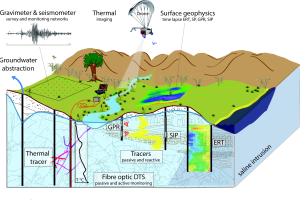The H+ network is the long-term observation network for hydrogeological research in France. It is part of the OZCAR network of critical zone observatories in France. The main objective of H+ is to produce monitoring and experimental data on subsurface structures and processes from highly instrumented sites. The H+ network was established in 2002, motivated by scientific questions concerning the impact of heterogeneity on flow, transport and reaction processes, with an emphasis on linking data and models, and on the development of hydrogeophysical methods.
Since then, the scientific questions undertaken by the H+ teams have diversified to include interactions and retroactions between subsurface and surface systems, and to develop links with other communities, such as geochemists, hydrologists, microbiologists and geomorphologists. This has been reinforced by interactions with catchment networks (RBVs), which led to the creation of the CRITEX equipment project in 2012 and the OZCAR critical zone research infrastructure in 2017.
The H+ network currently includes 5 highly instrumented sites: Auverwatch, Larzac, LSBB, Ploemeur and Poitiers. The H+ sites serve as experimental platforms to host international teams developing new subsurface monitoring and imaging techniques. SNO H+ coordinated the ITN ENIGMA (European training Network for in situ imaGing of dynaMic processes in heterogeneous subsurfAce environments) project and serves as an experimental platform for numerous ANR or ERC projects. Two sites of the network are respectively pilot sites of the European IR eLter and the PIA3 Terra Forma.

